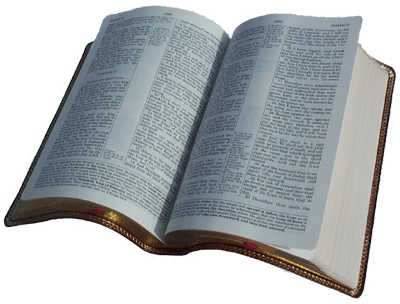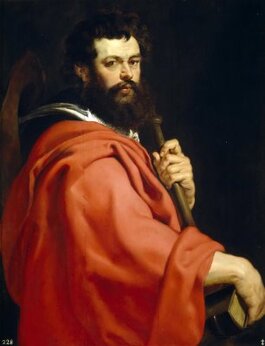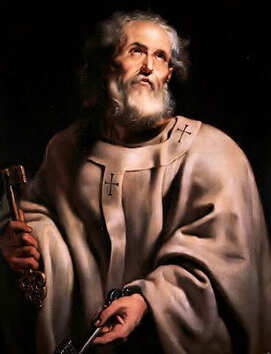Galatians 1:11-24 Lesson 359
Read both the "King James Bible" and the "New Living Translation."
In this lesson:
The Gospel comes from God, not man.
Why listen to Paul and not the Judaizers?
This lesson, through verse 2:21 (lesson 361), contains the
first of three topics in Galatians, Paul's defense of his apostolic credentials.
James and Peter.
By the Flemish Baroque artist Sir Peter Paul Rubens (1577-1640).
By the Flemish Baroque artist Sir Peter Paul Rubens (1577-1640).
Who was...
Peter -
Peter was the oldest of the twelve disciples. He was also called Simon Peter (2 Peter 1:1), Simeon (Acts 15:14), Simon Bar-jona (Matthew 16:17), meaning Simon, son of Jonah (Matthew 1:42), or just Simon (Matthew 10:2). The Greek translation for Peter is Petros (rock), the Aramaic is Cephas (John 1:42), and the Latin is Petrus. Peter was born in Bethsaida (John 1:44) on the northern coast of the Sea of Galilee. His father, Jona, was also called Jonah or Jonas (Matthew 21:15-17), and his younger brother was the disciple Andrew (John 1:40; 6:8). Peter was a simple fisherman in Capernaum (Matthew 4:18; Mark 1:16) and partners with James and John (Luke 5:10) when he met Jesus. Bold but uneducated (Acts 4:13), Peter (and Andrew) were the first disciples (Matthew 4:18-20; Mark 1:16-18) and part of Jesus' inner circle. Whenever Jesus was in Galilee, He used Peter's home as His base. Peter wrote the First and Second Epistles of Peter (1 Peter 1:1; 2 Peter 1:1). He walked on water (Matthew 14:28-31), performed the miracle at the Beautiful Gate (Acts 3:1-10), witnessed the Transfiguration of Jesus (Matthew 17:1-9; Mark 9:1-13; Luke 9:28-36; 2 Peter 1:16-18), the resurrection of Jairus' daughter (Mark 5:37-42), and Jesus praying in Gethsemane as He waited to be arrested (Mark 14:32-34). Peter rose before the mob to resist Jesus' arrest (John 18:10-13), yet within hours, he denied even knowing Him three times (Matthew 26:69-75). After the crucifixion, Peter became the rock on which Jesus built His church (Matthew 16:16-19) and helped spread the Gospel from Jerusalem to Rome. Whenever the Bible lists the twelve disciples/apostles, Peter is always listed first (Matthew 10:2-4; Mark 3:16-19), and Roman Catholics call him their first Pope. Peter was married (Matthew 8:14; Mark 1:30; Luke 4:38) and brought his wife on his missionary journeys (1 Corinthians 9:5). Although Jesus told Peter he would be crucified when he "shalt be old" (John 21:18-19), the Bible gives no details of his death. However, the Christian writers Quintus Septimius Florens Tertullianus (AD 160-220) and Origen Adamantius (AD 185-254) report that Peter was crucified upside down by Emperor Nero in Rome about AD 70, approximately three years after writing 2 Peter.
James -
James was a common name in biblical times. Counting two of Jesus' disciples, there are five James mentioned in the New Testament. This James was Jesus' half-brother (Mark 6:3; Galatians 1:19). James was not one of the original twelve disciples (Matthew 10:2-4). In fact, he did not believe that Jesus was the Messiah at first (John 7:5). James converted after the crucifixion and became one of the "pillars" in the Jerusalem church (Acts 12:17; 21:18; Galatians 2:9). He eventually succeeded Peter as its leader. He is also the author of "The General Epistle of James," written between AD 40-49, one of the earliest books in the New Testament. James was nicknamed "camel knees" due to his heavy calluses from praying. Known for his conservative religious views, he was called "James the Just," and he had the honor of a private meeting with the resurrected Christ (1 Corinthians 15:7). As a member of the council at Jerusalem, James sided with Paul and helped put an end to the Judaizer's debate which threatened to tear the young church apart (Acts 15:13-29; 21:18-24). Historian Flavius Josephus records that the Jewish high priest Ananus ben Ananus had James put to death in AD 62. James was dragged to the top of the Temple in Jerusalem and thrown off. He was severely injured but survived the fall. An angry mob then stoned him until a fuller (launderer) stepped out of the crowd and clubbed him to death with a pole used to beat dirty laundry.
Peter -
Peter was the oldest of the twelve disciples. He was also called Simon Peter (2 Peter 1:1), Simeon (Acts 15:14), Simon Bar-jona (Matthew 16:17), meaning Simon, son of Jonah (Matthew 1:42), or just Simon (Matthew 10:2). The Greek translation for Peter is Petros (rock), the Aramaic is Cephas (John 1:42), and the Latin is Petrus. Peter was born in Bethsaida (John 1:44) on the northern coast of the Sea of Galilee. His father, Jona, was also called Jonah or Jonas (Matthew 21:15-17), and his younger brother was the disciple Andrew (John 1:40; 6:8). Peter was a simple fisherman in Capernaum (Matthew 4:18; Mark 1:16) and partners with James and John (Luke 5:10) when he met Jesus. Bold but uneducated (Acts 4:13), Peter (and Andrew) were the first disciples (Matthew 4:18-20; Mark 1:16-18) and part of Jesus' inner circle. Whenever Jesus was in Galilee, He used Peter's home as His base. Peter wrote the First and Second Epistles of Peter (1 Peter 1:1; 2 Peter 1:1). He walked on water (Matthew 14:28-31), performed the miracle at the Beautiful Gate (Acts 3:1-10), witnessed the Transfiguration of Jesus (Matthew 17:1-9; Mark 9:1-13; Luke 9:28-36; 2 Peter 1:16-18), the resurrection of Jairus' daughter (Mark 5:37-42), and Jesus praying in Gethsemane as He waited to be arrested (Mark 14:32-34). Peter rose before the mob to resist Jesus' arrest (John 18:10-13), yet within hours, he denied even knowing Him three times (Matthew 26:69-75). After the crucifixion, Peter became the rock on which Jesus built His church (Matthew 16:16-19) and helped spread the Gospel from Jerusalem to Rome. Whenever the Bible lists the twelve disciples/apostles, Peter is always listed first (Matthew 10:2-4; Mark 3:16-19), and Roman Catholics call him their first Pope. Peter was married (Matthew 8:14; Mark 1:30; Luke 4:38) and brought his wife on his missionary journeys (1 Corinthians 9:5). Although Jesus told Peter he would be crucified when he "shalt be old" (John 21:18-19), the Bible gives no details of his death. However, the Christian writers Quintus Septimius Florens Tertullianus (AD 160-220) and Origen Adamantius (AD 185-254) report that Peter was crucified upside down by Emperor Nero in Rome about AD 70, approximately three years after writing 2 Peter.
James -
James was a common name in biblical times. Counting two of Jesus' disciples, there are five James mentioned in the New Testament. This James was Jesus' half-brother (Mark 6:3; Galatians 1:19). James was not one of the original twelve disciples (Matthew 10:2-4). In fact, he did not believe that Jesus was the Messiah at first (John 7:5). James converted after the crucifixion and became one of the "pillars" in the Jerusalem church (Acts 12:17; 21:18; Galatians 2:9). He eventually succeeded Peter as its leader. He is also the author of "The General Epistle of James," written between AD 40-49, one of the earliest books in the New Testament. James was nicknamed "camel knees" due to his heavy calluses from praying. Known for his conservative religious views, he was called "James the Just," and he had the honor of a private meeting with the resurrected Christ (1 Corinthians 15:7). As a member of the council at Jerusalem, James sided with Paul and helped put an end to the Judaizer's debate which threatened to tear the young church apart (Acts 15:13-29; 21:18-24). Historian Flavius Josephus records that the Jewish high priest Ananus ben Ananus had James put to death in AD 62. James was dragged to the top of the Temple in Jerusalem and thrown off. He was severely injured but survived the fall. An angry mob then stoned him until a fuller (launderer) stepped out of the crowd and clubbed him to death with a pole used to beat dirty laundry.
Study Tip:
Put difficult passages into your own words.
This gives you a better understanding of the verse and helps you retain it longer.
Put difficult passages into your own words.
This gives you a better understanding of the verse and helps you retain it longer.












